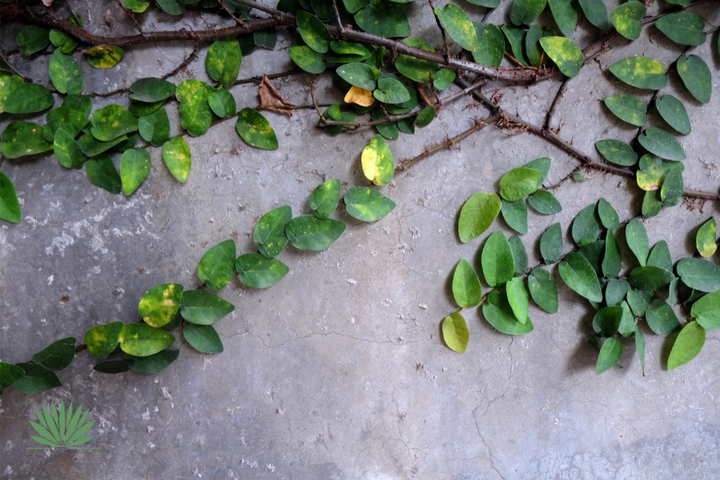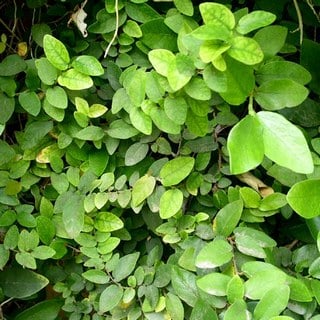Creeping fig is different than most vines grown in the desert. It seldom flowers, prefers shade, and clings to almost any structure without support. It’s not an “all-purpose” desert vine but can be a good choice in the right spot. Here’s everything you need to know to decide whether it’s a good fit for your garden, plus how to take care of any new or existing plants.

Creeping fig (Ficus pumila) is an Asian native that sets itself apart from most vines grown in the desert in a number of ways.
Unlike most desert vines, it stays evergreen and is grown for its foliage, not its flowers. It seldom blooms and when it does, flowers are inconspicuous, rather than showy.
It prefers shade over hot sunny walls. While you can provide a trellis or fence, it doesn’t need support to climb. It clings to walls and other surfaces by aerial rootlets.
It has two distinct leaf types. When young, this plant’s leaves are small and heart shaped. As the plant matures, its new leaves are thick, leathery, and nearly four inches long.
Another feature that changes with time is the growth rate. Young plants grow slowly, but eventually, pick up the pace to grow vigorously.
Why You May Like This Plant
- Forms a dense evergreen screen
- Clings to structures without support
- Low maintenance, low litter
But this vine has some potential downsides.
Things to Watch Out For
The desert southwest is not creeping fig’s preferred location. Plants prefer high humidity, part shade, and moist, fertile soil. The fact they grow reasonably well here in spite of this is a testament to their resilience and adaptability.
Just because it’s a Ficus, doesn’t mean it produces delicious fruits. It produces a scant number of fruits, which are considered inedible.
Creeping fig has aerial rootlets that will adhere to and climb just about any surface — stucco, concrete, brick, and even metal. These rootlets often leave permanent marks on any surface they attach to.
A University of Arizona publication warns against growing within 40 feet of a water feature to avoid structural
damage from plant roots.
Plant stems exude milky sap that can cause contact irritation in some people.
The ASPCA does not list it as toxic to cat or dogs, but it does list other members of the Ficus genus as toxic. According to other reputable sources, it can cause intestinal distress if ingested, so err on the side of caution.
Optimal Growing Conditions
If you’re thinking of adding creeping fig to your garden, you need to find a suitable place that will keep it healthy and looking good… while minimizing maintenance for you.
Here are the key factors to keep in mind.
Temperature
Creeping fig should be grown in USDA Hardiness Zones 8 – 11. It tolerates desert heat, but only if doesn’t get too much sun. It’s evergreen and more cold hardy than its appearance suggests — down to around 10℉.

Sun Exposure
Creeping fig does best in part or full shade. It tolerates morning sun provided it gets afternoon shade. Its best locations are on north or east facing walls. Plants struggle when grown on sunny west or south facing walls.
Size and Growth Rate
Creeping fig starts as a slow-grower but picks up speed as it matures, ultimately reaching a size of 20 feet tall and wide, or even larger. It can eventually become an aggressive grower to the point of being a nuisance.
Soil
Creeping fig prefers moist, well-draining soil, high in organic matter. Obviously, our dry, rocky, desert soil which is low in organic matter is not ideal.
Pests & Diseases
Creeping fig is prone to spider mites during hot, dry summers. (Frequently spraying this vine with your garden hose can is an easy way to keep their numbers under control.)
This Asia native often experiences iron chlorosis in our alkaline desert soil.
Creeping Fig:
The Essentials
| Common Name | Creeping fig |
| Scientific Name | Ficus pumila |
| Origin | East Asia |
| Plant Type | Evergreen vine |
| USDA Zones | Zones 8 – 11 |
| Cold Hardiness | To 10℉ |
| Flowers | Inconspicuous |
| Flower Season | Spring |
| Mature Size | 20′ high x 20′ wide |
| Growth Rate | Slow, then fast |
| Sun Tolerance | Part, full shade |
| Water Needs | Moderate |
| Pests & Diseases | Iron chlorosis, spider mites |
| Cautions | Contact dermatitis, possibly toxicity |
| Wildlife | Deer resistant |
How to Plant
The rule of thumb when planting any vine in the desert is to dig a hole three times as wide as the root ball but no deeper.
Since creeping fig prefers fertile soil, consider amending your hole with compost or a commercial soil mix, and top with organic mulch
When to Plant
The best time to plant creeping fig is in the fall. This gives your vine three seasons to grow roots and get established before the following summer.
The second best time is in spring, the earlier the better. This still gives your plant time to get established before the intense heat of June arrives.
How to Care for Creeping Fig
Whether you’ve recently planted a creeping fig or have an existing plant in your yard, here’s how to take care of it to keep it healthy and looking its best.
How to Water New Plants
Once you’ve got your creeping fig in the ground, watering is your most immediate concern. Here is a recommended watering schedule for new vines planted in the spring or fall.
| Weeks 1 & 2 | Every 3 – 4 days |
| Weeks 3 & 4 | Every 6 – 7 days |
| Weeks 5 & 6 | Every 7 – 10 days |
| Weeks 7 & 8 | Every 10 – 14 days |
After week 8, gradually revise your watering schedule, depending on the season.
How to Water Established Plants
Creeping fig is not considered a drought tolerant plant and likes a moderate amount of water. Here’s a suggested watering schedule for subsequent years.
| Spring & Fall | Every 10 – 14 days |
| Summer | Every 7 – 10 days |
| Winter | Every 14 – 21 days |
Should You Fertilize?
There’s no need to fertilize creeping fig. It grows vigorously without fertilizer.
How to Prune
It’s generally recommended that you give creeping fig a hard prune in the spring every few years for size reduction and rejuvenation. Hard pruning will revert the plant’s leaves back to their juvenile form (i.e., smart heart-shaped leaves), if that’s the look you prefer.
Plant Lover Facts
Creeping fig (Ficus pumila) also goes by the common name climbing fig.
It’s native to parts of East Asia including China, Japan, Korea, Laos, Taiwan, and Vietnam. It has naturalized in isolated pockets around the world, including the US states of Florida and Alabama.
Did you enjoy this article?
Sign up for our weekly newsletter
where you’ll find more great info on creating &
maintaining a beautiful, carefree desert landscape.
Author Bio
Deane Alban is the creator of Southwest Gardener. She is a science writer with a bachelor’s degree in botany from the University of South Florida. Gardening is her lifelong passion. She’s been gardening in Tucson for over 15 years.

